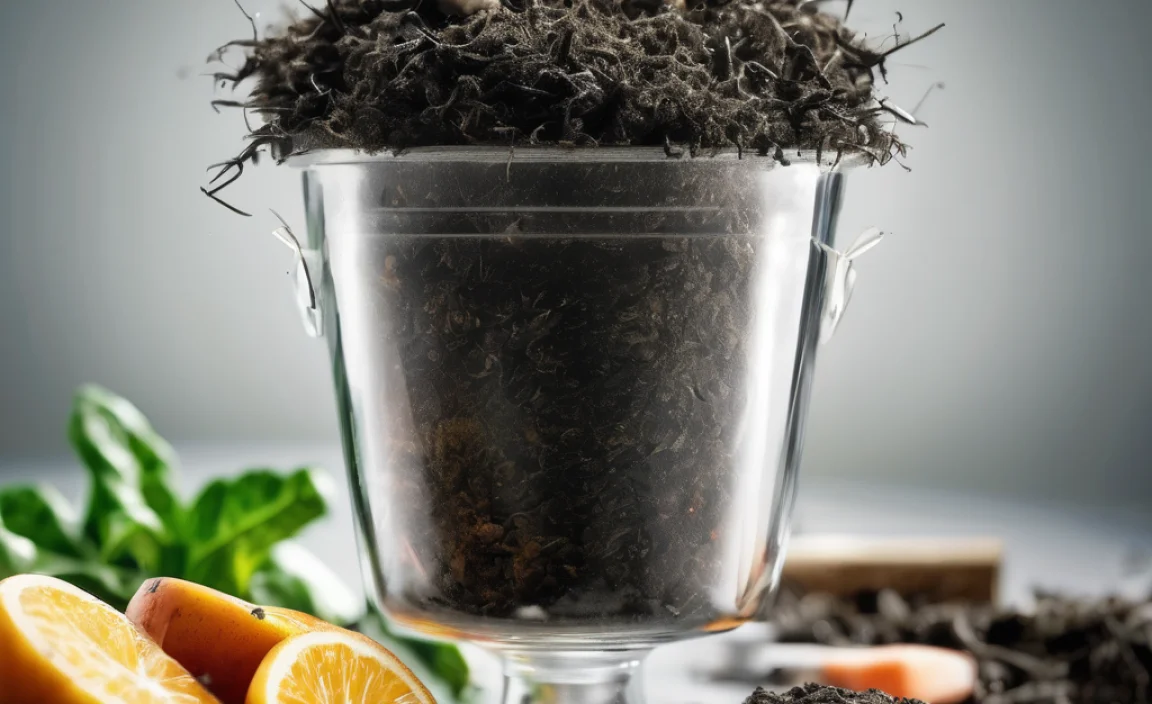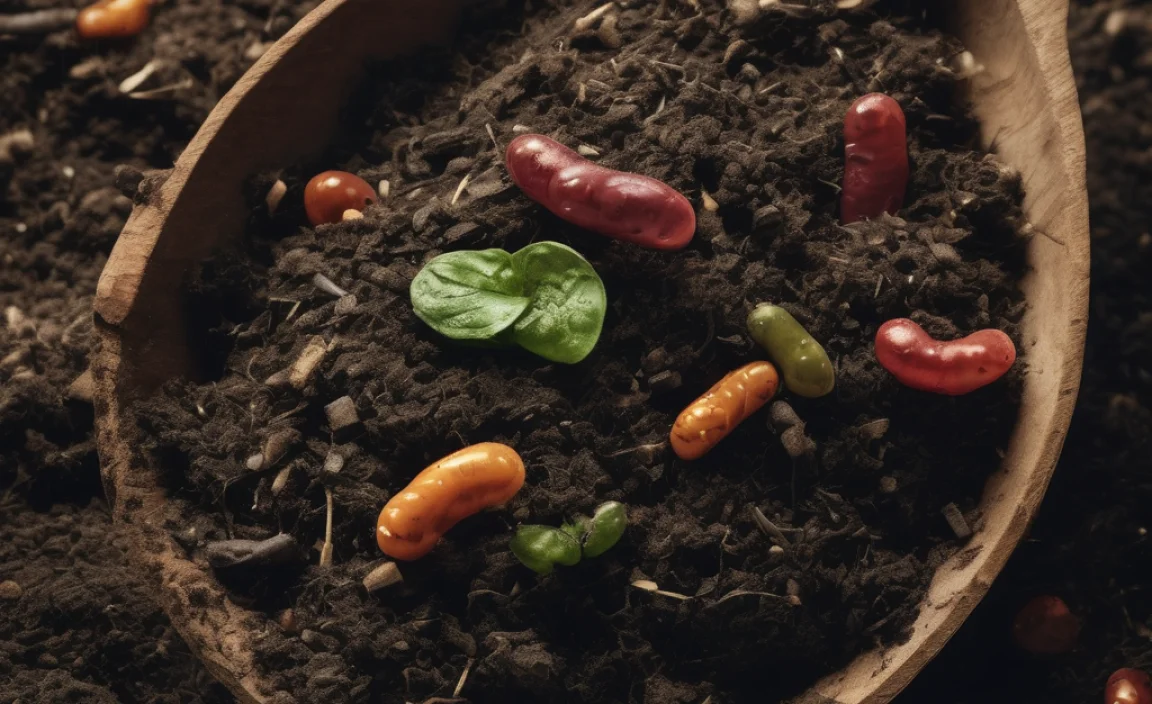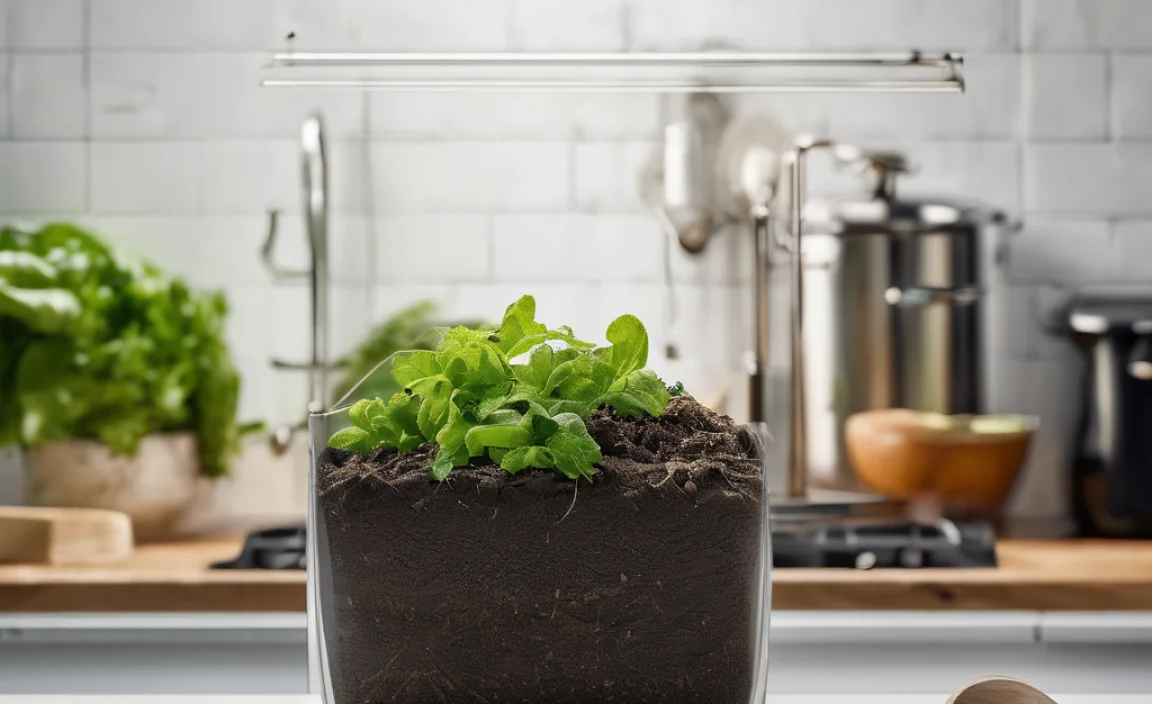Ever look at your compost bin and wonder what’s really going on in there? It’s a whole underground world! Understanding the tiny organisms, especially their balance, is key to fast, effective compost. Don’t worry if it sounds complicated; we’ll break it down simply. Getting this right turns kitchen scraps into garden gold. Let’s unlock the secrets of compost microbes!
Compost Microbes Ratio: The Essential Balance for Happy Composting
Hey there, fellow home improvers and garden lovers! Troy D Harn here from TopChooser. We’ve all been there – staring at a compost bin filled with various bits of kitchen scraps and yard waste, hoping for the best. But what if I told you there’s a hidden secret to making that compost magic happen faster and better? It’s all about the tiny, unseen heroes: the microbes. And guess what? They thrive when things are just right, especially when their “crew” is in the proper ratio.
Think of your compost pile like a bustling city of microscopic life. You’ve got your busy workers (bacteria) and your helpful cleanup crew (fungi and actinomycetes). For this city to run smoothly and break down your organic materials efficiently, these different groups need to work together harmoniously. Getting the “compost microbes ratio” right is like ensuring you have the right mix of team members with different skills. Too many of one, and things can get out of whack. Too few of another, and decomposition slows to a crawl. Don’t sweat it if this sounds a bit science-y; we’re going to make it super simple and practical. By the end of this, you’ll know exactly what’s needed to create a microbe paradise in your compost bin, turning your waste into nutrient-rich “black gold” for your garden with ease.
Why Microbes Matter in Your Compost Pile

So, why all the fuss about tiny microbes? Because they are the undisputed champions of decomposition! Without them, your banana peels and grass clippings would just sit there, slowly drying out or rotting, but not transforming into the fluffy, dark, soil-enriching compost we all desire. These microscopic organisms are the workhorses that chomp, break down, and convert organic matter into simpler compounds that plants love.
There are three main types of microbes that are crucial for composting:
- Bacteria: These are the most abundant group. They do the heavy lifting, especially in the early, hotter stages of composting. They break down sugars and starches quickly.
- Fungi: Think of fungi as the long-term breakdown specialists. They are particularly good at tackling tougher materials like woody stems and tough grass clippings that bacteria might struggle with.
- Actinomycetes: These are a fascinating bunch, often described as a hybrid between bacteria and fungi. They are responsible for that earthy, pleasant smell of healthy compost and help break down materials that are a bit more challenging.
The magic happens when these different microbes work in concert. They consume the organic materials you add, respire, and reproduce, releasing heat and producing the nutrient-rich compost. The speed and efficiency of this process are directly related to the microbial community within the pile. If one group is overpowering or another is scarce, the whole operation can falter.
The Critical Compost Microbes Ratio: Understanding the Balance

Now, let’s talk numbers, but don’t worry, we’re not pulling out a calculator! When we discuss the “compost microbes ratio,” we’re really talking about the optimal conditions that allow these different microbial groups to thrive. It’s less about exact counts and more about creating an environment where the right players are present and active.
The primary factor influencing microbial populations and their activity is the Carbon-to-Nitrogen (C:N) ratio of your compostable materials. This is probably the most talked-about ratio in composting, and for good reason!
The Carbon (Browns) vs. Nitrogen (Greens) Equation
Think of carbon-rich materials as the “browns” and nitrogen-rich materials as the “greens.”
- Browns (Carbon-rich): These provide energy for the microbes. They are typically dry and decompose slowly. Examples include:
- Dry leaves
- Straw and hay
- Shredded cardboard and newspaper (ink-free)
- Wood chips and sawdust (use sparingly)
- Twigs and small branches
- Greens (Nitrogen-rich): These provide the protein and nutrients for the microbes to grow and multiply. They are usually moist and decompose quickly. Examples include:
- Fruit and vegetable scraps
- Grass clippings
- Coffee grounds and filters
- Tea bags
- Manure (from herbivores like cows, horses, chickens, rabbits)
- Plant trimmings (non-woody)
Bacteria, the primary decomposers, need both carbon (for energy) and nitrogen (for building new cells). Fungi and actinomycetes also have their preferences, but providing a balanced C:N ratio generally supports all of them.
Why the “Ideal” C:N Ratio is Around 25:1 to 30:1
Research and practical composting experience have shown that a C:N ratio of roughly 25:1 to 30:1 by weight is ideal for rapid and efficient composting.
What does this mean in practice?
- Too much nitrogen (too many greens): Your compost pile can become dense, wet, and smelly (like ammonia). This environment favors anaerobic bacteria that produce foul odors. The decomposition process slows down.
- Too much carbon (too many browns): The microbes won’t have enough nitrogen to multiply effectively. Decomposition will be very slow, and your pile might not heat up enough to kill weed seeds or pathogens.
So, the “compost microbes ratio” is indirectly controlled by your C:N ratio. When you get this balance right, you’re essentially feeding the diverse microbial community in the way they need to thrive and do their best work.
A good rule of thumb for beginners is to aim for about two to three parts browns to one part greens by volume. This is a simpler way to approach the C:N ratio when you’re starting out, as measuring by weight can be tricky.
The Role of Other Environmental Factors
While the C:N ratio is the star player, other elements are crucial for keeping your microbial community happy and balanced:
- Moisture: Microbes need water to live and move. A compost pile should feel like a wrung-out sponge – moist but not soggy. Too dry, and activity stops. Too wet, and you risk going anaerobic (stinky!).
- Aeration (Oxygen): Most beneficial composting microbes are aerobic, meaning they need oxygen to survive and work efficiently. Turning your compost pile regularly introduces air, preventing anaerobic conditions and promoting faster breakdown.
- Temperature: Different microbes are active at different temperatures. The intense heat (thermophilic phase) is primarily driven by bacteria and is crucial for killing weed seeds and pathogens. As the pile cools, different microbes, including fungi and actinomycetes, take over for the curing process.
- Particle Size: Smaller pieces have more surface area for microbes to attack. Chopping up larger materials like branches or a whole cabbage makes them decompose much faster.
Achieving the Right Compost Microbes Ratio: Practical Steps

Now for the practical part! How do you actually do this? It’s simpler than it sounds. It’s mostly about mindful layering and occasional intervention.
Step 1: Gather Your Materials Wisely
As we discussed, having a good mix of browns and greens is key. Try not to overload your bin with only one type of material at a time. If you do a big yard cleanup and have tons of grass clippings (greens), remember to offset it with plenty of dry leaves or shredded cardboard (browns).
Step 2: Layering is Your Friend
When you add materials to your compost bin, try to layer your greens and browns. A common method is to add a layer of browns, then a layer of greens, then another layer of browns, and so on. This helps ensure that everything is mixed well from the start.
Pro Tip: If you have a very “wet” green material like kitchen scraps, you can even add some dry brown material (like shredded newspaper or straw) directly on top to absorb excess moisture and odor.
Step 3: Proper Moisture Management
Periodically check the moisture level of your compost. Stick your hand into the pile. If it feels dry, water it down, preferably while turning. If it feels too wet and dense, add more brown materials and turn it to introduce air.
A simple way to maintain moisture is to cover your compost bin, especially during dry spells. However, ensure the cover allows for some air circulation.
Step 4: Aeration is Non-Negotiable
This is where turning your compost comes in. How often you need to turn depends on your goals:
- For fast compost (hot composting): Turn every 3-7 days once the pile heats up. This is crucial for keeping aerobic microbes happy.
- For slower compost (cold composting): You can get away with turning every few weeks or even just a few times a year. It will still break down, just at a much slower pace.
There are many ways to turn your compost. You can use a pitchfork to move the outer layers to the center and vice-versa. Specialized compost aerators are also available that make this task easier.
Here’s a quick table showing how different materials contribute to your C:N ratio. Keep in mind these are approximate values by weight.
| Material Type | Typical C:N Ratio (Approximate by Weight) | Category |
|---|---|---|
| Leaves (Dry) | 40:1 to 80:1 | Brown |
| Straw | 40:1 to 100:1 | Brown |
| Shredded Newspaper | 150:1 to 200:1 | Brown |
| Wood Chips/Sawdust | 200:1 to 500:1 | Brown (use sparingly) |
| Fruit & Vegetable Scraps | ~15:1 | Green |
| Grass Clippings (Fresh) | ~10:1 to 20:1 | Green |
| Coffee Grounds | ~20:1 | Green |
| Manure (Herbivore) | ~10:1 to 25:1 | Green |
As you can see, mixing a few handfuls of coffee grounds (low C:N) with a large volume of dry leaves (high C:N) is a great way to inch towards that ideal 25-30:1 ratio.
Step 5: Size Matters!
Chop, shred, or tear larger items before adding them to the compost bin. This dramatically increases the surface area available for microbial attack. A whole pumpkin will take ages to break down; a chopped-up pumpkin will be compost much faster.
Think about it: the smaller the pieces, the more places microbes can get to work on them!
Step 6: Patience and Observation
Composting is a living process. Keep an eye on your pile. Does it smell? Add browns and turn. Is it dry? Add water and turn. Is it not breaking down? Ensure you have a good mix of greens and browns, and that it’s moist. The more you observe, the better feel you’ll get for your specific compost pile.
Common Composting Problems and Their Microbe-Related Solutions

Sometimes, despite our best efforts, compost piles can encounter issues. These are often directly linked to an imbalanced microbial environment.
Problem: Your Compost Smells Bad (Rotten Egg, Ammonia)
- Cause: This is almost always a sign of anaerobic conditions – too little oxygen. It means you likely have too many “greens” (nitrogen) which can lead to a dense, waterlogged pile that suffocates the beneficial aerobic microbes.
- Solution: Add plenty of “browns” (carbon-rich materials like dry leaves, straw, shredded cardboard) to absorb excess moisture and provide more energy for the microbes. Turn the pile thoroughly to introduce air. This helps shift the microbial population back to aerobic, odor-free decomposers.
Problem: Your Compost is Not Heating Up or Decomposing Slowly
- Cause: This typically means you have too few “greens” (nitrogen), or the pile is too dry, or both. The microbes don’t have enough protein (nitrogen) to multiply and generate heat, or they lack the water they need to be active.
- Solution: Add more “greens” like kitchen scraps, fresh grass clippings, or manure. Water the pile if it’s dry. Ensure it’s moist like a wrung-out sponge. If the material is in large pieces, chop it smaller to increase surface area.
Problem: Too Many Flies or Pests
- Cause: Exposed food scraps (greens) are a major attractant. Also, a pile that is too wet or not hot enough can encourage certain pests.
- Solution: Always bury fresh kitchen scraps (greens) under a layer of browns. Ensure your compost pile is kept moist but not waterlogged. Turning the pile regularly can also help deter pests and promote faster decomposition, leading to reduced attraction. Using a compost bin with a lid can also help.
The Importance of a Lively Microbial Community

A healthy, active microbial community means faster composting. This is the goal for many home composters looking to turn waste into usable compost in a matter of weeks or months, rather than years. These tiny workers are the engine of your compost pile, and their balance dictates the speed and quality of the final product.
By consistently managing your compost’s C:N ratio, moisture, and aeration, you are effectively cultivating the perfect environment for a diverse and robust microbial population. This leads to a compost pile that works efficiently, smells pleasant, and produces nutrient-rich compost that will do wonders for your garden.
Compost Microbe Ratio: Key Takeaways for Success
Let’s quickly recap the essential points for keeping your compost microbes happy and your compost pile working effectively:
- Understand Browns and Greens: Aim for a balance. Greens provide nitrogen, keeping microbes active and multiplying. Browns provide carbon, giving them energy.
- The Magic Ratio: While exact numbers are complex, a good practical goal is 2-3 parts browns to 1 part greens by volume. This generally translates to the ideal C:N ratio for microbial efficiency.
- Moisture is Vital: Your compost should feel like a wrung-out sponge. Too dry slows things down; too wet causes stinky anaerobic conditions.
- Air is Essential: Aerobic microbes need oxygen. Turn your compost regularly to keep it airy and prevent bad smells.
- Size Reduction: Smaller particles offer more surface area for microbes to munch on, speeding up decomposition.
- Observe and Adjust: Pay attention to smells, moisture, and temperature. Adjust your brown/green mix and turning schedule as needed.
Successfully managing these elements means you’re not just filling a bin with waste; you’re managing a dynamic, living ecosystem. And that ecosystem’s health is directly tied to the “compost microbes ratio” – their balance driven by the conditions you provide.
FAQ: Your Beginner Compost Microbes Questions Answered
What are the primary types of microbes involved in composting?
The main players are bacteria, fungi, and actinomycetes. Bacteria are the fastest workers, fungi tackle tougher materials, and actinomycetes help with decomposition and give compost its earthy smell.
Is it possible to know the exact compost microbes ratio in my pile?
For home composting, it’s not practical or necessary to know the exact ratio of microbes. Instead, focus on creating the right environment (C:N balance, moisture, air) that supports a healthy and diverse microbial community.
How does the Carbon-to-Nitrogen (C:N) ratio affect the compost microbes?
The C:N ratio is critical because it dictates the food source for microbes. Bacteria, the primary decomposers, need both carbon (for energy) and nitrogen (for building new cells). An ideal C:N ratio (around 25:1 to 30:1) provides the perfect balance for them to thrive and multiply.
What happens if my compost has too much nitrogen (too many greens)?
Too much nitrogen can lead to an overly wet, dense pile that lacks oxygen (anaerobic conditions). This favors strong
.lwrp.link-whisper-related-posts{
margin-top: 40px;
margin-bottom: 30px;
}
.lwrp .lwrp-title{
}.lwrp .lwrp-description{
}
.lwrp .lwrp-list-container{
}
.lwrp .lwrp-list-multi-container{
display: flex;
}
.lwrp .lwrp-list-double{
width: 48%;
}
.lwrp .lwrp-list-triple{
width: 32%;
}
.lwrp .lwrp-list-row-container{
display: flex;
justify-content: space-between;
}
.lwrp .lwrp-list-row-container .lwrp-list-item{
width: calc(25% – 20px);
}
.lwrp .lwrp-list-item:not(.lwrp-no-posts-message-item){
max-width: 150px;
}
.lwrp .lwrp-list-item img{
max-width: 100%;
height: auto;
object-fit: cover;
aspect-ratio: 1 / 1;
}
.lwrp .lwrp-list-item.lwrp-empty-list-item{
background: initial !important;
}
.lwrp .lwrp-list-item .lwrp-list-link .lwrp-list-link-title-text,
.lwrp .lwrp-list-item .lwrp-list-no-posts-message{
}@media screen and (max-width: 480px) {
.lwrp.link-whisper-related-posts{
}
.lwrp .lwrp-title{
}.lwrp .lwrp-description{
}
.lwrp .lwrp-list-multi-container{
flex-direction: column;
}
.lwrp .lwrp-list-multi-container ul.lwrp-list{
margin-top: 0px;
margin-bottom: 0px;
padding-top: 0px;
padding-bottom: 0px;
}
.lwrp .lwrp-list-double,
.lwrp .lwrp-list-triple{
width: 100%;
}
.lwrp .lwrp-list-row-container{
justify-content: initial;
flex-direction: column;
}
.lwrp .lwrp-list-row-container .lwrp-list-item{
width: 100%;
}
.lwrp .lwrp-list-item:not(.lwrp-no-posts-message-item){
max-width: initial;
}
.lwrp .lwrp-list-item .lwrp-list-link .lwrp-list-link-title-text,
.lwrp .lwrp-list-item .lwrp-list-no-posts-message{
};
}

I am passionate about home engineering. I specialize in designing, installing, and maintaining heating, ventilation, and air conditioning systems. My goal is to help people stay comfortable in their homes all year long.
